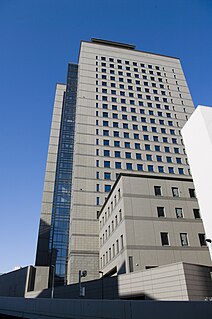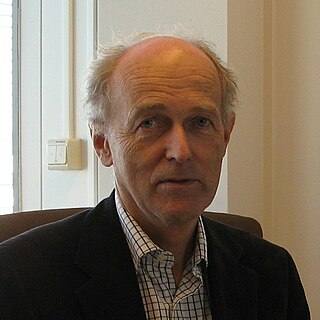
Kristen Nygaard was a Norwegian computer scientist, programming language pioneer, and politician. Internationally, Nygaard is acknowledged as the co-inventor of object-oriented programming and the programming language Simula with Ole-Johan Dahl in the 1960s. Nygaard and Dahl received the 2001 A. M. Turing Award for their contribution to computer science.
John Florian Sowa is an American computer scientist, an expert in artificial intelligence and computer design, and the inventor of conceptual graphs.
Information science is an academic field which is primarily concerned with analysis, collection, classification, manipulation, storage, retrieval, movement, dissemination, and protection of information. Practitioners within and outside the field study the application and the usage of knowledge in organizations in addition to the interaction between people, organizations, and any existing information systems with the aim of creating, replacing, improving, or understanding information systems.
Biosemiotics is a field of semiotics and biology that studies the prelinguistic meaning-making, or production and interpretation of signs and codes and their communication in the biological realm.
Community informatics (CI) is an interdisciplinary field that is concerned with using information and communication technology (ICT) to empower members of communities and support their social, cultural, and economic development. Community informatics may contribute to enhancing democracy, supporting the development of social capital, and building well connected communities; moreover, it is probable that such similar actions may let people experience new positive social change. In community informatics, there are several considerations which are the social context, shared values, distinct processes that are taken by members in a community, and social and technical systems. It is formally located as an academic discipline within a variety of academic faculties including information science, information systems, computer science, planning, development studies, and library science among others and draws on insights on community development from a range of backgrounds and disciplines. It is an interdisciplinary approach interested in using ICTs for different forms of community action, as distinct from pure academic study about ICT effects.
The International Federation for Information Processing (IFIP) is a global organisation for researchers and professionals working in the field of computing to conduct research, develop standards and promote information sharing.

The National Institute of Informatics is a Japanese research institute located in Chiyoda, Tokyo, Japan. NII was established in April 2000 for the purpose of advancing the study of informatics. This institute also works on creating systems to facilitate the spread of scientific information to the general public. It oversees and maintains a large, searchable information database on a variety of scientific and non-scientific topics called Webcat. NII is the only comprehensive research institute in informatics in Japan. It is a major part of the Graduate University for Advanced Studies, SOKENDAI, and since 2002 has offered a Ph.D. program in informatics.
The International Federation for Systems Research(IFSR) is an international federation for global and local societies in the field of systems science. This federation is a non-profit, scientific and educational agency founded in 1980, and constituted of some forty-five member organizations from various countries.

An ontology chart is a type of chart used in semiotics and software engineering to illustrate an ontology.

Jean Leonardus Gerardus (Jan) Dietz is a Dutch Information systems researcher, Emeritus Professor of Information Systems Design, and part-time Professor of Enterprise Engineering at the Delft University of Technology, known for the development of the Design & Engineering Methodology for Organizations. and his work on enterprise ontology.
John Krogstie is a Norwegian computer scientist, professor in information systems at the Norwegian University of Science and Technology (NTNU) in Trondheim, Norway, and an expert in the field of enterprise modelling.
Ronald K. (Ron) Stamper is a British computer scientist, formerly a researcher in the LSE and emeritus professor at the University of Twente, known for his pioneering work in Organisational semiotics, and the creation of the MEASUR methodology and the SEDITA framework.

Cliff Joslyn is an American cognitive scientist, cybernetician, and currently Chief Knowledge Scientist and Team Lead for Mathematics of Data Science at the Pacific Northwest National Laboratory in Seattle, Washington, USA.
Informatics is the study of computational systems, especially those for data storage and retrieval. According to ACM Europe andInformatics Europe, informatics is synonymous with computer science and computing as a profession, in which the central notion is transformation of information. In other countries, the term "informatics" is used with a different meaning in the context of library science.
The Tartu–Moscow Semiotic School is a scientific school of thought in the field of semiotics that was formed in 1964 and led by Juri Lotman. Among the other members of this school were Boris Uspensky, Vyacheslav Ivanov, Vladimir Toporov, Mikhail Gasparov, Alexander Piatigorsky, Isaak I. Revzin, and others. As a result of their collective work, they established a theoretical framework around the semiotics of culture.
Pervasive informatics is the study of how information affects interactions with the built environments they occupy. The term and concept were initially introduced by Professor Kecheng Liu during a keynote speech at the SOLI 2008 international conference.
The following outline is provided as an overview of and topical guide to semiotics:
Copenhagen–Tartu school of biosemiotics is a loose network of scholars working within the discipline of biosemiotics at the University of Tartu and the University of Copenhagen.

Eckhard D. Falkenberg is a German scientist and Professor Emeritus of Information Systems at the Radboud University Nijmegen. He is known for his contributions in the fields of information modelling, especially object-role modeling, and the conceptual foundations of information systems.
Kecheng Liu is a Chinese/British expert in organisational semiotics a professor of applied informatics at the University of Reading, and a professor of management science and engineering.





